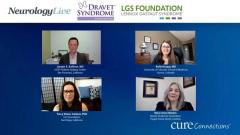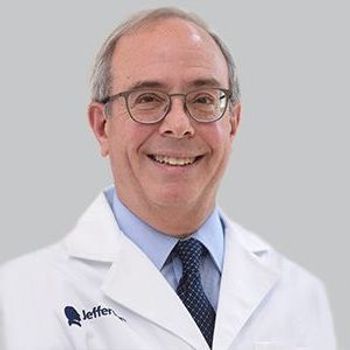
Patient Journey to LGS Diagnosis
Tracy Dixon-Salazar, PhD, reflects on her daughter’s journey to diagnosis of Lennox-Gastaut Syndrome and the impact of the disease on caregivers.
Episodes in this series

Joseph E. Sullivan, MD: You’re testing a lot. I want to get into what you see as a typical patient journey, let’s start the journey, thinking back to when your daughter was diagnosed with LGS and you are neuroscientist and I have heard your story so many times and it always brings me to tears. There was a delay in suspecting that at least LGS diagnosis, not to mention the calcium overactivation disorder but just the LGS diagnosis. Can you share a little bit about that?
Tracy Dixon-Salazar, PhD: I wasn’t a neuroscientist back then. I was a 23-year-old mother of 2 kids. I hadn’t done well in high school. She only had her first seizure out of the blue in the middle of the night. It was tonic clonic, we had no idea it was tonic clonic, we thought she was chocking. And then 2 weeks later, she had another seizure, a tonic clonic, a month later she had another seizure, tonic clonic during the day, not at night and then 2 weeks after that she had another seizure tonic clonic, and then she went 6 months and didn’t have any seizures at all. We had gotten in immediately to see a pediatric neurologist. We got great care for that time. And then when she was 3, the seizures came on and they came on with a vengeance. Six different seizures on EEG, 100s of seizures a day and then that was our norm for the next 16 years. She wasn’t diagnosed with LGS until she was 5 when she went in for surgical workup and overnight 3 day EEG they came in after a day and said she has had too many seizures to count, you don’t have to stay for 3 days, she is not a candidate for surgery, and she has Lennox Gastaut syndrome. She is 29 years old now. This was back in 1998. We didn’t have EME monitoring like we do now, but all we knew back then was what was in the textbooks. LGS is catastrophic epilepsy syndrome. The prognosis is continued seizures, progressive intellectual disability, and premature death. That was it. That’s all I knew. Prior to that when she was 2 and seizing, doctors had said things to us like you can’t die from epilepsy. Seizures don’t damage the brain, and thankfully we don’t need to know what causes seizures in order to treat them. And they did because that was the dogma, not because there was anything negative about – that was the approach back then. But none of those things were true. We are seeing her become progressively brain damage up to the age of 5. We are resuscitating her, and the medications are not working. We did start treating when she was 3. We never talk about the medicines that make things catastrophically worse. We don’t like to talk about that in our patients, but she has had a few of those and maybe that exacerbated. Maybe there is a second hit in LGS that cause them to develop because not every kid evolves into LGS if you have the risk factors. But that was our journey, and she had been cognitively normal. Nobody expected that we were not going to be able to control her epilepsy and we were devastated. We lost a lot of trust in the medical system until we realized that they were working on the operating knowledge they had, but we thought we had been lied to and obviously that was not the case.
Joseph E. Sullivan, MD: You said that she was developmentally normal even after those first few seizures when 6 months was out. And then when that horrible day where she had many, how long did it take for you to start seeing some changes in her?
Tracy Dixon-Salazar, PhD: About 6 months. It’s hard. She was 3 years old. She was on all these medicines, we started monotherapy. We tried tegretol first, she got a rash, we cried. Depakote next, that one made her self-injurious and homicidal. She was just nuts. And then we tried dilantin as a third, phenytoin as a third, and within 6 months but it’s hard to know. It’s like what was medications what was seizures, and you have all the haters that were emerging and things like that but it was 6 months, we knew she was behind and then by the time we got the LGS diagnosis – I had read about LGS and I suspected it but it never hit me as oh she has that because there was just – I mean I had to check out internet time at a library. Back then there was a lot of information out there at the time. It’s much more now which is wonderful.
Joseph E. Sullivan, MD: Like you said it wasn’t that your treating physicians at that time were incompetent. It was just status of things and now Kelly and I, we have the luxury of having genetic testing that we can get. We can get video EEG within a day if we need to and we now have the luxury of knowing that it does make a difference if we make this diagnosis. Maybe the patient journey now is different than it was 10 years ago and hopefully that is leading to a better outcomes, at least what we hope for.
Tracy Dixon-Salazar, PhD: We are seeing a lot of families in our group that are coming in much younger, 1, 1.5 years old, 2 years old, that are getting in a lot earlier. Our understanding that there is this evolving and our understanding like it’s not the doctors that are failing you, it’s the treatment, it’s science and medicine have not gotten to the point where they can help in a lot of ways, but you don’t want to stop trying. And then families are supported. They are supported by other caregivers who have been there, done that. It’s faster and better. If you look at health claims data, if you look at medical claims data, most patients aren’t seen by the Kelly Knupp and Joe Sullivan’s of the world. Most LGS patients are seen out in general neurology or general practice even, it’s important for us to try to get them to see to you guys and know that there is hope on the horizon for these families.
Joseph E. Sullivan, MD: This is a momentum in our field that people – pediatric epilepsy is already a subspecialize enough but now it’s getting that you’re a DEE specialist and then you are LGS, which is great. There is a lot of stuff going on and the pace of advances is crazy. It’s hard to keep to keep up and if we’re going to be doing our patients and their families justice that they deserve and give them the state of art then you almost do need to have this niche. That’s not to say that there is no role for a good card-carrying pediatric epileptologist that sees at all. I certainly have no ego, if I have something that I have only seen a few cases of and I know that my colleague has 5 or 10 of them, send them over there for second opinion because they are going to be in better hands. I am curious you commented a lot in terms of so many seizures and just being in constant crisis mode. This is something we hear a lot of our general DEE patients but certainly Lennox Gastaut. Having to be on them 24x7 because they are going to fall and end up with skull injury. I am wondering maybe share your personal journey and journey of some of your families in terms of how do those things impact your day-to-day ability to function as a family?
Tracy Dixon-Salazar, PhD: For that 16-year period, from the time she was 3 till the time she was 18 when we found out her genetic diagnosis and tried the medicine for that, that reduced her seizures by 95% and stopped her status. She was going into status 2 to 4 times a week and getting at home rescue medications and when that didn’t work we go to the ER [emergency room]. We put her into coma if that didn’t work. For that 16-year period, that’s where most of the families that we work with live and having surveyed our families extensively and having held out patient for development meeting in recent years, we have come out with this hierarchy of needs for LGS. Just if you guys remember, Maslow's hierarchy if needs from a psyche class. If you want to live your full life at the top of the pyramid your basic needs must meet like food, clothing, water, shelter, social belongingness, love, feeling proud of yourself. And there is hierarchy of needs for our caregivers that impact our caregivers and our LGS level more. Although, in some ways they are happier than we are in some ways because they don’t realize how sick they are until they are in it and then they are so mentally young. My daughter is mental age of 2- to 7-year-old depending how this goes. She doesn’t comprehend that she is different, but the hierarchy is basically at the bottom of the pyramids. I don’t mean this to sound glib but is death. We have a lot of death in our community and then above that is crisis, all the things I have talked about, being in the hospital, being in the throes of a seizure status and seizures are more than just the actual event, it’s like all the pre stuff and the post stuff and cleaning up the pee and the poop. Now we have to sleep or not making it to work. You’ve got the injuries, drowning possibility, aspiration pneumonia. These are the crisis pieces of epilepsy, and we are just constantly trying to keep our kids out of crisis, they are going to go into crisis but and above that on the pyramid are they just doing the basic life skills. Are they eating, sleeping, drinking, pooping, peeing, and taking their medications and generally staying safe. These 7 things take all of our time. These 7 things will help them to not go into crisis, they are still going to go into crisis but these seven things are what we spend all our time on. And then above that on the pyramid is do they do any of those 7 things themselves, and the answer is never yes. We don’t know what’s at the top of the pyramid and we don’t know what self-actualization looks like in LGS space because our needs are so low on that pyramid as caregivers and our kids are they are so much suffering and so much devastation, so much brain damage that’s happening across the course of their LGS that they are suffering down there with us. That’s really been the journey. Most families are still living in that going into crisis all the time and then doing everything, all the care giving for the rest of their lives. I have been a caregiver for 29 years now for my daughter and will be for as long as I am able and she lives. It’s this never ending, and I that’s where most families on the LGS journey are living in that constant crisis and care giving and waiting for the next crisis to happen because it’s going to.
Transcript Edited for Clarity
Newsletter
Keep your finger on the pulse of neurology—subscribe to NeurologyLive for expert interviews, new data, and breakthrough treatment updates.
































